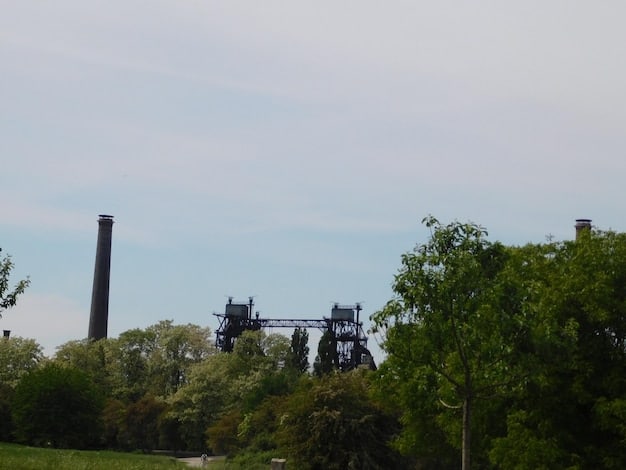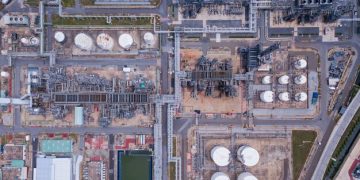Carbon Capture in the US: Are Pilot Projects Ready for Prime Time?

Recent pilot projects in the US are testing the viability of carbon capture technologies, aiming to reduce carbon emissions from power plants and industrial facilities, but questions remain about their scalability, cost-effectiveness, and long-term impact.
The urgency to combat climate change has spurred innovation in carbon capture technologies. Are Carbon Capture Technologies Finally Viable? Analyzing Recent Pilot Projects in the US is crucial to understanding the potential of these advancements, particularly in sectors heavily reliant on fossil fuels.
Understanding Carbon Capture: An Overview
Carbon capture technology aims to capture carbon dioxide (CO2) emissions from sources like power plants and industrial facilities, preventing them from entering the atmosphere. This captured CO2 can then be stored underground (carbon sequestration) or used for other purposes (carbon utilization).
The concept of carbon capture has been around for decades, but only recently have advancements in technology and increased urgency to address climate change made it a more prominent focus. The U.S. is at the forefront of testing and deploying these technologies.
Different Carbon Capture Methods
Several methods exist for capturing CO2, each with its own advantages and disadvantages. These include:
- Post-Combustion Capture: This involves removing CO2 from flue gas after combustion, commonly used in power plants.
- Pre-Combustion Capture: This method converts fuel into a mixture of hydrogen and CO2 before combustion, making CO2 capture easier.
- Oxy-Fuel Combustion: Burning fuel in pure oxygen produces a concentrated stream of CO2, simplifying capture.
The Role of Government and Private Sector
Both government initiatives and private sector investments are driving the development and deployment of carbon capture technologies in the U.S. Government funding supports research and pilot projects, while private companies are innovating and commercializing these technologies.

Carbon capture technology has the potential to play a significant role in reducing carbon emissions and mitigating climate change. As pilot projects continue to demonstrate their effectiveness and efficiency, carbon capture may become an increasingly vital strategy for decarbonizing the energy sector.
Recent Carbon Capture Pilot Projects in the US
Several pilot projects in the U.S. are testing different carbon capture technologies across various industries. These projects provide valuable insights into the feasibility, cost, and performance of carbon capture in real-world settings.
These pilot projects serve as critical learning opportunities, helping to refine carbon capture technologies and identify best practices for deployment at scale.
Petra Nova Project
The Petra Nova project in Texas was one of the earliest large-scale carbon capture projects in the U.S. It involved capturing CO2 from a coal-fired power plant and using it for enhanced oil recovery (EOR).
- The project aimed to demonstrate the viability of carbon capture technology on a commercial scale.
- It faced challenges, including high costs and operational issues.
- Despite its challenges, Petra Nova provided valuable lessons for future carbon capture projects.
Illinois Industrial Carbon Capture and Storage Project
This project in Illinois captures CO2 from an ethanol production facility and stores it underground. It demonstrates the potential for carbon capture in the biofuels industry.
The project has successfully captured and stored thousands of tons of CO2, providing valuable data on the long-term storage of CO2 underground.

Pilot projects like Petra Nova and the Illinois Industrial Carbon Capture and Storage Project are helping to advance carbon capture technology and pave the way for larger-scale deployment.
Evaluating the Viability of Carbon Capture Technologies
While carbon capture technologies show promise, several factors must be considered to assess their overall viability. These include cost-effectiveness, scalability, and environmental impact.
Understanding these factors is crucial for determining whether carbon capture can play a significant role in achieving decarbonization goals.
Cost-Effectiveness
The cost of carbon capture is a major barrier to its widespread adoption. Capturing CO2, transporting it, and storing it can be expensive.
Technological advancements and economies of scale can help reduce the cost of carbon capture, making it more competitive with other decarbonization strategies.
Scalability
Carbon capture technologies must be scalable to have a significant impact on reducing carbon emissions. This means that they must be able to be deployed across a wide range of industries and geographic locations.
Scaling up carbon capture requires significant investment in infrastructure and research and development.
Environmental Impact
Carbon capture technologies can have both positive and negative environmental impacts. While they can reduce carbon emissions, they can also require significant energy input and create other environmental challenges.
- Careful consideration must be given to the lifecycle environmental impacts of carbon capture technologies.
- The long-term storage of CO2 underground must be carefully monitored to prevent leaks and ensure environmental safety.
Overall, the viability of carbon capture technologies depends on addressing challenges related to cost, scalability, and environmental impact. Continued investment in research and development is essential for improving the performance and reducing the cost of these technologies.
Policy and Regulatory Framework for Carbon Capture in the US
Government policies and regulations play a critical role in shaping the development and deployment of carbon capture technologies in the U.S. Supportive policies can incentivize investment and accelerate the adoption of carbon capture.
The U.S. government has implemented several policies to support carbon capture, including tax credits, funding for research and development, and regulatory frameworks for carbon storage.
45Q Tax Credit
The 45Q tax credit provides financial incentives for capturing and storing CO2. This credit has been instrumental in driving investment in carbon capture projects.
Revisions to the 45Q tax credit have made it more attractive to investors, increasing the potential for carbon capture deployment.
Infrastructure Investment and Jobs Act
The Infrastructure Investment and Jobs Act includes significant funding for carbon capture research, development, and deployment. This funding will support the construction of carbon capture facilities and the development of carbon storage infrastructure.
The act also focuses on creating jobs and economic opportunities in communities impacted by the energy transition.
Supportive government policies are essential for creating a favorable environment for carbon capture technologies. These policies can help to overcome barriers to deployment and accelerate the transition to a low-carbon economy.
Challenges and Opportunities in Carbon Capture Deployment
While carbon capture technologies offer a pathway to reduce carbon emissions, several challenges and opportunities exist in their deployment. Addressing these challenges is crucial for realizing the full potential of carbon capture.
Overcoming these challenges will require collaboration between government, industry, and research institutions.
Technical Challenges
Technical challenges include improving the efficiency and reducing the cost of carbon capture technologies.
Research and development efforts are focused on developing new materials, processes, and designs that can improve the performance of carbon capture systems.
Economic Challenges
Economic challenges include securing financing for carbon capture projects and developing sustainable business models.
- Innovative financing mechanisms, such as public-private partnerships, can help to overcome these challenges.
- The development of markets for captured CO2 can also create new revenue streams and improve the economic viability of carbon capture.
Social and Environmental Considerations
Social and environmental considerations include addressing concerns related to the safety and environmental impact of carbon storage.
Public engagement and education are crucial for building support for carbon capture projects and ensuring that they are implemented in a responsible manner.
Future Directions for Carbon Capture Technologies
The future of carbon capture technologies depends on continued innovation, investment, and policy support. Several promising areas of research and development could further enhance the viability and impact of carbon capture.
These future directions include:
Direct Air Capture
Direct air capture (DAC) involves removing CO2 directly from the ambient air. This technology has the potential to capture CO2 emissions from dispersed sources, providing a complementary approach to capturing emissions from point sources.
DAC is still in the early stages of development, but it holds great promise for addressing climate change.
Carbon Utilization
Carbon utilization involves using captured CO2 to create valuable products, such as building materials, fuels, and chemicals.
- This approach can create new markets for captured CO2 and improve the economic viability of carbon capture.
- Carbon utilization can also help to reduce the demand for fossil fuels and promote a circular economy.
Integration with Renewable Energy
Integrating carbon capture with renewable energy sources can create a synergistic approach to decarbonization. For example, using renewable energy to power carbon capture facilities can reduce their overall carbon footprint.
As renewable energy becomes more affordable and widespread, integrating it with carbon capture will become increasingly attractive.
| Key Aspect | Brief Description |
|---|---|
| 🌱 Carbon Capture | Technology that captures CO2 emissions from sources like power plants, preventing their release into the atmosphere. |
| 💰 Cost Factors | High costs remain a barrier, but innovations can reduce them. Government incentives and market creation for captured CO2 can help. |
| 🏭 Pilot Projects | Projects like Petra Nova in Texas and the Illinois Industrial Carbon Capture project offer testing grounds but can face operational challenges. |
| 🌎 Future Tech | Direct Air Capture and Carbon Utilization are promising avenues for advancement, along with integrating carbon capture with renewable energy. |
Frequently Asked Questions
▼
Carbon capture involves capturing CO2 emissions from sources like power plants and industrial facilities. The captured CO2 is then either stored underground or used for other purposes. This prevents the gas from entering the atmosphere.
▼
Yes, the high cost is a primary barrier. The process requires advanced technologies and infrastructure for capture, transportation, and storage or usage, which adds to the capital and operational costs.
▼
One notable project was the Petra Nova project in Texas. The Illinois Industrial Carbon Capture and Storage Project is another example, capturing CO2 from an ethanol production plant for underground storage.
▼
Carbon utilization involves using captured CO2 to create valuable products like building materials or chemicals. This approach can help turn waste into resources and improve the economics of carbon capture.
▼
Government policy and incentives, such as the 45Q tax credit, are essential to support the deployment of carbon capture. Policies can help overcome financial barriers and encourage private sector investment in these technologies.
Conclusion
In conclusion, while carbon capture technologies show promise in reducing carbon emissions, their viability hinges on addressing economic, technical, and social challenges. Continued innovation, supportive policies, and strategic investments are essential to unlock the full potential of these technologies in the fight against climate change.




